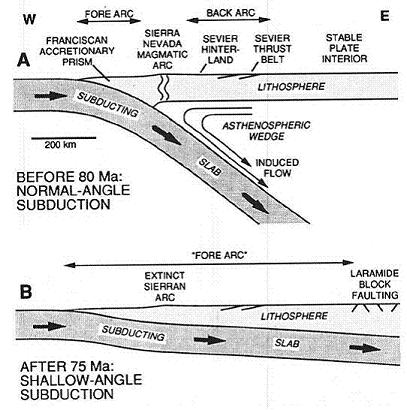Flat Slab Subduction
Flat slab subduction is the dramatic shallowing of the angle of subduction between two tectonic plates. In normal subduction zones the angle of subduction is on the order of 30 degrees. In the case of a
flat slab, the subduction angle shallows to something on the order of 5 degrees, with local sections flattening even further. Flat slab subduction can be seen ongoing in several locations around the world
today. In South America the Nazca oceanic plate is subducting beneath the South American continental plate, and in multiple locations it has a shallow angle. By studying these analogs we can learn more
about the processes associated with flat slab subduction and perhaps infer details about the Laramide slab.

from Dumitru 1991
When a subducting plate transitions from a normal subducting angle to a shallow angle, asthenosphere is displaced and squeezed out in the direction of subduction. This process has several implications.
First, without asthenosphere, the magmatic arc normally positioned over subduction zones loses its main source for magmatism. As a result, the magmatic zone near the point of subduction shuts off and
magmatism propagates in the same direction as the asthenospheric wedge. Second, replacing hot asthenosphere below the crust with colder subducted lithosphere will cool the continental geotherm which will in
turn serve to strengthen the lithosphere. (Dumitru et al., 1991)
Another consequence of having the lower and overriding plates in much closer proximity to each other is the possibility of coupling between them. This coupling would induce a basal traction on the bottom of
the lower crust of the upper plate, which in turn would have several impacts. Lower crust basal traction would localize horizontal compressive stresses at the margin of the coupling zone, and is often cited
as a mechanism for creating deformation far away from the subduction zone. Coupling of the two plates would also require the creation of a lower crustal shear zone to accommodate the motion between the
plates. This shear zone would greatly aid the motion of lower crustal flow away from the subduction zone and could cause crustal thickening in the direction of transport (i.e. the Rocky Mountain foreland
and Great Plains (see article on crustal thickening by Greg Benson)). (Bird 1988, 1998)

from Bird 1988
When hypothesizing about the flat slab subduction in the Laramide, scientists have disagreed about the possible extents of the flat slab zone. On one end of the spectrum, Bird 1988 postulates that a flat
slab could have been present over much of the western U.S. during Laramide time. (see figure). This model proposes widespread removal of the mantle lithosphere and plate coupling in the western U.S. to
create the deformation we see during the Laramide. On the other end of the spectrum, Livaccari and Perry 1993 accept some form of flat slab subduction during the Laramide, however they dispute the claim
that it was largely responsible for the deformation seen. They cite the isotopic geochemistry data discussed below as evidence for preservation of mantle lithosphere throughout the Laramide Orogeny.
Instead of plate coupling, they propose that the deformation was caused by increased end loading at the subduction zone and see this stress being transferred eastward by a cold/strong section of continental
lithosphere akin to the Tarim Basin in Tibet. (Bird 1988, 1998, Livaccari and Perry 1993)